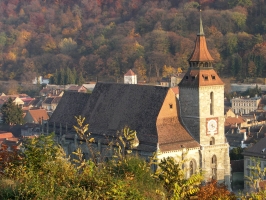The Black Church Archives and Library is one of the most valuable confessional repositories in Transylvania and a significant cultural institution of the Transylvanian Saxons in Braşov. The institution preserves a rich heritage of archive material and old books from the sixteenth and seventeenth centuries. Before the establishment of the Black Church Archives and Library, the local traditional cultural institutions of the Transylvanian Saxons, such as the Honterus High School and the regional evangelical consistory, used to collect and conserve the cultural heritage of the German community in Romania. Among the most significant archival collections of the Black Church Archives and Library, it is worth mentioning the Joseph Franz Trausch Collection (1795–1871), the Markus Fronius Collection (1659–1713), the Hans Otto Roth Collection (1890–1953), and the Oskar Netoliczka Collection (1865–1940).
The Black Church Archives and Library were established in 1958 under the official name The Archives of the Honterus Parish Community in accordance with a law of 1957 regulating the functioning of church archives. This law was meant to provide a legal framework for the confessional archives which were operating outside the control of the state. The communist authorities wanted to register the archival collections that churches had hidden after 1945 out of fear that these collections might be seized by the state. The activity of the new officially established archives was to be supervised by the State Archives. The establishment of the Black Church Archives and Library took place after a period (1945–1958) during which most of the cultural institutions of the Transylvanian Saxons in Braşov had been closed and their heritage had been nationalised by the communist regime. The most difficult moment was in 1945, when the soviet occupation troops threw the archives and the library of the Honterus High School out of the window into the street because the building had been requisitioned in order to be transformed into a military hospital. The people of Braşov managed to save a part of the documents and books by forming a human chain that carried them from hand to hand to the attic of the Black Church, one of the most impressive gothic churches in Transylvania and a symbol of the city of Braşov. In 1948, the State Archives nationalised the greater part of the archival collections and old books of historical value owned by the local evangelic church of Braşov. However, some of the collections escaped this nationalisation process of 1948, due either to the lack of professional training of the State Archives employees or to the manoeuvres of the church employees who managed to hide them. Ten years later, when the Black Church Archives and Library were established, the political context had become totally different, because the communist authorities had decided in the meantime that the Romanian Germans should be re-integrated into the new society after many years of repressive measures took against them. After the establishment of the Black Church Archives and Library in 1958, the new institution took over the archives and old books in the possession of the Honterus High School and the local archives of the Evangelical Church that had been saved from the nationalisation of 1948. Gustav Markus – former owner of the Corvinus Publishing House during the interwar period – had a key role in the establishment of the new institution. Between 1958 and 1962, he managed to archive the greater part of the collections. Markus also played a significant role in saving and officially including in the archives registry even collections which were problematic, such as those created by several personalities of the Transylvanian Saxons who were labelled as “enemies” by the communist regime or those dealing with the opposition to the nationalisation process conducted by the communist regime in the period 1945–1948.
Between 1958-1976, the collections of the Black Church Archives and Library were accessed by researchers from Romania, the Federal Republic of Germany, and Hungary. Following Decree no. 471 of 1971, which stipulated that the State Archives were to take over those collections that were not related to the current activity of the churches, the Black Church Archives and Library had to conform and gave up the custody of its most valuable collections (Șindilariu 2005, 50–52). Following these institutional changes, the Black Church Archives and Library was transformed from an institution dedicated to making its collections accessible to the general public into an internal archival office meant to serve the administrative activity of the Honterus Evangelical parish church. This situation lasted until 2005, when under the co-ordination of the historian and archivist Thomas Șindilariu, the Black Church Archives and Library was re-established. Since then, many researchers from Romania, Germany, Hungary, Switzerland, and the United Kingdom have accessed its collections.

